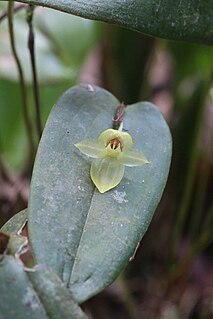
Pleurothallis is a genus of orchids commonly called bonnet orchids. The genus name is derived from the Greek word pleurothallos, meaning "riblike branches". This refers to the rib-like stems of many species. The genus is often abbreviated as "Pths" in horticultural trade.

Octomeria is a plant genus belonging to the family Orchidaceae. The genus comprises about 150 species native to the Neotropics, mostly in Brazil.

Barbosella is a genus of mostly creeping orchids. The genus has about 20 species, widespread across the West Indies and Latin America from Mexico and the Lesser Antilles to Argentina. Named after João Barbosa Rodrigues, an investigator of Brazilian orchids. They have solitary flowers with a unique lip base that works like a ball and socket.

Brachionidium is a genus of about 72 species of orchids, found throughout much of tropical America. The generic name comes from Greek and refers to the protrusions on the stigma.
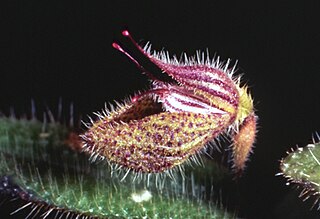
Dresslerella is a genus of miniature orchids, with about 13 species native to South and Central America. The genus is named after orchidologist Robert L. Dressler. Some species are noted to be pubescent.
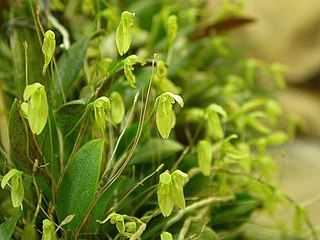
Pleurothallopsis is a genus of orchids comprising about 18 species native to western South America and southern Central America.
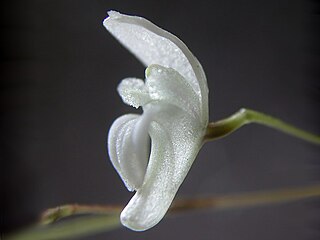
Pabstiella is a small orchid genus belonging to the subfamily Epidendroideae. They occur in Central and Tropical America.

Specklinia is a genus of orchids native to South America, Central America, and the Caribbean. It contains approximately 100 species.

Laeliinae is a Neotropical subtribe including 40 orchid genera, such as Brassavola, Laelia and Cattleya. The genus Epidendrum is the largest within this subtribe, containing about 1500 species. This is followed by the genus Encyclia, with over 120 species.

Acianthera is a genus of orchids native to the tropical parts of the Western Hemisphere, especially Brazil. It was first described in 1842 but was not widely recognized until recently. Most of the species formerly placed under Pleurothallis subgenus Acianthera. This splitting is a result of recent DNA sequencing.

Mormodes, abbreviated as Morm. in the horticultural trade, is a genus of approximately 70-80 species of terrestrial and epiphytic orchids native to Mexico, Central America and South America.
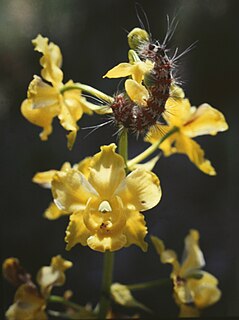
Cyrtopodium, often abbreviated Cyrt in horticulture, is a genus of more than 40 species of epiphytic and terrestrial orchids found from Florida and Mexico through Argentina. Cyrtopodium is the only genus in the monotypic subtribe Cyrtopodiinae.
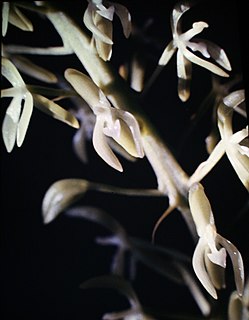
Notylia, abbreviated Ntl in horticultural trade, is a genus of orchids. It consists of 56 recognized species, native to Mexico, Central America, Trinidad and South America.

Epidendrum secundum, one of the crucifix orchids, is a poorly understood reed stemmed species, which Dressler (1989) describes as "the Epidendrum secundum complex." According to Dressler, there are dozens of varieties, some of which appear to deserve species rank. Arditti and Ghani note that E. secundum has the distinction of bearing the longest seeds known in the Orchidaceae, 6.0 mm long. By comparison, the seeds of E. ibaguense are only 2.9 mm long.

Cyclopogon is a genus of flowering plants from the orchid family, Orchidaceae. It is a fairly large genus distributed widely over much of South America, the Galápagos, Central America, Mexico and the West Indies, with 2 species (C. elatus + C. cranichoides) in southern Florida.

Epistephium is a genus of flowering plants from the orchid family, Orchidaceae. It is native to South America, with a few species in Belize and Trinidad.
- Epistephium amabileSchltr.
- Epistephium amplexicaulePoepp. & Endl.
- Epistephium brevicristatumR.E.Schult.
- Epistephium duckeiHuber
- Epistephium elatumKunth in F.W.H.von Humboldt, A.J.A.Bonpland & C.S.Kunth
- Epistephium ellipticumR.O.Williams & Summerh.
- Epistephium frederici-augustiRchb.f. & Warsz.
- Epistephium hernandiiGaray
- Epistephium lamprophyllumSchltr.
- Epistephium laxiflorumBarb.Rodr.
- Epistephium lobulosumGaray
- Epistephium lucidumCogn. in C.F.P.von Martius
- Epistephium matogrossenseHoehne
- Epistephium parviflorumLindl.
- Epistephium portellianumBarb.Rodr.
- Epistephium praestansHoehne
- Epistephium sclerophyllumLindl.
- Epistephium sessiliflorumLindl.
- Epistephium speciosumBarb.Rodr.
- Epistephium subrepensHoehne
- Epistephium williamsiiHook.f.
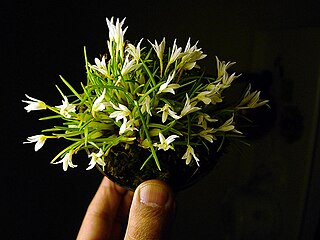
Christensonella is a genus of orchids native to Mexico, South America and Central America.
- Christensonella echinophyta(Barb.Rodr.) Szlach., Mytnik, Górniak & Smiszek - Espírito Santo, Rio de Janeiro
- Christensonella ferdinandiana(Barb.Rodr.) Szlach., Mytnik, Górniak & Smiszek - Brazil
- Christensonella huntii(Christenson) S.Koehler - Peru
- Christensonella macleei(Bateman ex Lindl.) Solano - Oaxaca, Central America
- Christensonella nardoides(Kraenzl.) Szlach., Mytnik, Górniak & Smiszek - Peru, Ecuador, Bolivia
- Christensonella neowiedii(Rchb.f.) S.Koehler - Argentina, Brazil
- Christensonella pacholskii(Christenson) S.Koehler - Peru, Ecuador, Brazil
- Christensonella pachyphylla(Schltr. ex Hoehne) Szlach., Mytnik, Górniak & Smiszek - Brazil
- Christensonella paranaensis(Barb.Rodr.) S.Koehler - Argentina, Brazil
- Christensonella pumila(Hook.) Szlach., Mytnik, Górniak & Smiszek - Peru, Guyana
- Christensonella seidelii(Pabst) Szlach., Mytnik, Górniak & Smiszek - Rio de Janeiro
- Christensonella subulata(Lindl.) Szlach., Mytnik, Górniak & Smiszek - Brazil
- Christensonella subulifolia(Schltr.) S.Koehler - Colombia
- Christensonella uncata(Lindl.) Szlach., Mytnik, Górniak & Smiszek - Brazil, Venezuela, Colombia, Peru, Ecuador, Bolivia, the Guianas

Cattleya × elegans is a hybrid orchid in the subtribe Laeliinae. It is a pseudobulb epiphyte. Its formula hybridae is Cattleya purpurata Van den Berg (2008) × Cattleya tigrina A.Rich. (1848). It is found in South and South-East Brazil.


















